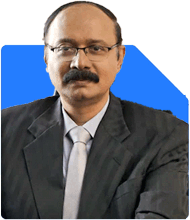48-Year-Old Earning 2.5L Seeks Investment Advice for Early Retirement in 2026
Ramalingam Kalirajan |10893 Answers |Ask -Follow
Mutual Funds, Financial Planning Expert - Answered on Dec 04, 2024
He has an MBA in finance from the University of Madras and is a certified financial planner.
He is the director and chief financial planner at Holistic Investment, a Chennai-based firm that offers financial planning and wealth management advice.... more

Sir, Im a 48yrs old, my monthly salary is 2.5L my expense and my family expense i need 1L per month. I planning to leave my work from June-2026. In-between this period i can invest a month 1.5L. I can invest from this Dec-2024,So where i can invest for my future, which plan is best return give to me?. If i invest mutual fund or stack market or Nifty -50, how many year need to invest? minimum. 1 year or 1.5 year can invest monthly basis? or 5 years above plan only have.? Pls give me your guidance. Im confusing about . Thanks & Regards Prakash from Thanjavur, Dt
Age: 48 years.
Monthly Salary: Rs. 2.5L.
Expenses: Rs. 1L per month.
Monthly Savings Potential: Rs. 1.5L from Dec 2024 to June 2026.
Retirement Planned: June 2026 (1.5 years away).
Your focus should be on ensuring financial security post-retirement and balancing short-term and long-term returns.
Key Investment Strategy
1. Short-Term Investments (1.5 Years)
Since your investment horizon is limited, focus on low-risk options with stable returns.
Debt Mutual Funds: Ideal for low volatility and reasonable returns. Use short-duration or liquid funds for flexibility.
Fixed Deposits or Recurring Deposits: Use these for safe, guaranteed returns with easy liquidity.
Sovereign Bonds (T-Bills): Consider Treasury Bills for short-term secure returns.
Avoid heavy exposure to equities or Nifty-50 for this period due to potential market volatility.
2. Post-Retirement Monthly Income Plan
After retiring in June 2026, ensure a steady cash flow with the following allocation:
Systematic Withdrawal Plan (SWP): Invest a portion in balanced or conservative hybrid funds to withdraw monthly income while preserving capital.
Senior Citizens’ Savings Scheme (SCSS): Once eligible at 60, invest for a regular, safe income with high returns.
Debt Instruments: Keep part of your corpus in FDs or debt mutual funds for liquidity.
3. Long-Term Growth Strategy
If you can continue investing beyond June 2026, allocate part of your corpus to equity for inflation-beating growth:
Equity Mutual Funds: Diversify across large-cap, mid-cap, and multi-cap funds for growth.
SIP in Nifty-50 Index Funds: These are suitable for moderate risk-takers seeking simple, long-term returns.
Balanced Advantage Funds: Ideal for long-term goals with dynamic asset allocation.
For long-term equity investments, a horizon of 5+ years is recommended to mitigate market volatility.
Step-by-Step Plan for Monthly Savings (1.5 Years)
Allocate Rs. 1.5L monthly as follows:
Rs. 75,000 (50%): Debt mutual funds or fixed deposits for short-term stability.
Rs. 45,000 (30%): Balanced advantage funds for moderate risk and growth.
Rs. 30,000 (20%): Large-cap equity funds or Nifty-50 index funds for long-term growth (only if you extend beyond 1.5 years).
Additional Recommendations
Emergency Fund: Ensure you have at least Rs. 12-15L as an emergency fund before investing aggressively.
Health Insurance: Upgrade your health insurance to cover unforeseen medical expenses post-retirement.
Tax Planning: Maximise benefits under Section 80C through ELSS, PPF, or EPF. Use other tax-saving instruments as applicable.
Avoid Overexposure to Stocks: Direct stock investments are riskier unless you have expertise. Stick to diversified mutual funds.
Final Insights
For 1.5 years, focus on low-risk investments like debt funds and FDs.
Extend equity investments for at least 5 years to see meaningful growth.
Balance risk and returns by diversifying across asset classes.
Regularly review your portfolio and adjust based on retirement needs.
For personalised planning, connect with a Certified Financial Planner to align investments with your retirement goals.
Best Regards,
K. Ramalingam, MBA, CFP,
Chief Financial Planner,
www.holisticinvestment.in
https://www.youtube.com/@HolisticInvestment
You may like to see similar questions and answers below
Sanjeev Govila | Answer |Ask -Follow
Financial Planner - Answered on Jun 15, 2023
Ramalingam Kalirajan |10893 Answers |Ask -Follow
Mutual Funds, Financial Planning Expert - Answered on Jun 18, 2024
Ramalingam Kalirajan |10893 Answers |Ask -Follow
Mutual Funds, Financial Planning Expert - Answered on Jul 17, 2024
Milind Vadjikar | Answer |Ask -Follow
Insurance, Stocks, MF, PF Expert - Answered on Dec 19, 2024
Ramalingam Kalirajan |10893 Answers |Ask -Follow
Mutual Funds, Financial Planning Expert - Answered on Dec 15, 2025
Ramalingam Kalirajan |10893 Answers |Ask -Follow
Mutual Funds, Financial Planning Expert - Answered on Dec 15, 2025
Radheshyam Zanwar |6746 Answers |Ask -Follow
MHT-CET, IIT-JEE, NEET-UG Expert - Answered on Dec 15, 2025
Ramalingam Kalirajan |10893 Answers |Ask -Follow
Mutual Funds, Financial Planning Expert - Answered on Dec 15, 2025
Ramalingam Kalirajan |10893 Answers |Ask -Follow
Mutual Funds, Financial Planning Expert - Answered on Dec 15, 2025
Ramalingam Kalirajan |10893 Answers |Ask -Follow
Mutual Funds, Financial Planning Expert - Answered on Dec 15, 2025
Samraat Jadhav |2508 Answers |Ask -Follow
Stock Market Expert - Answered on Dec 15, 2025
Ramalingam Kalirajan |10893 Answers |Ask -Follow
Mutual Funds, Financial Planning Expert - Answered on Dec 15, 2025
Reetika Sharma |425 Answers |Ask -Follow
Financial Planner, MF and Insurance Expert - Answered on Dec 15, 2025
Radheshyam Zanwar |6746 Answers |Ask -Follow
MHT-CET, IIT-JEE, NEET-UG Expert - Answered on Dec 15, 2025


























